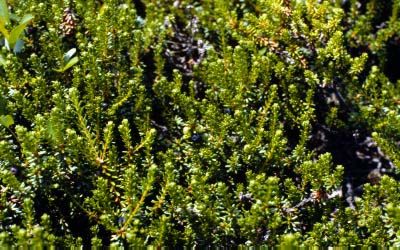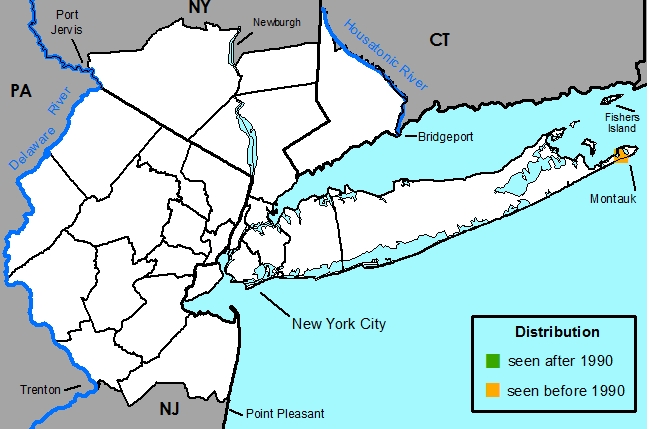Empetrum nigrum var hermaphroditum (Hagerup) T. J. Sørensen - Black Crowberry

Black Crowberry
Photo © Steven Clemants, 1981, taken in Maine.
Common Names
Black CrowberryField Identification
Small shrubs with needle-like leaves and small, axillary nonshowy flowers.Food uses
Disclaimer: The information provided here is for reference and historical use. We do not recommend nor do we condone the use of this species for food purposes without first consulting a physician.The berries are edible and are eaten by many northern people. They are made into a beverage with sour milk in Iceland and eaten with seal fat in Greenland. "The fruits ... are consumed in a ripe or dry state by the Indians of the Northwest, are eaten by the Tuski of Alaska and are gathered in autumn by the western Eskimo and frozen for winter food" (Hedrick, 1972).
Common names
Berry-Girse
Blackberry
Black Crowberry
Corbigeau
Crane
Crawberry
Crawcrooks
Crawcroups
Crow Ling
Curlew-Berry
Deer's Grass
Graines À Corbigeau
Heath
Heat-Urts
Knauperts
Lingberry
Monnocs-Heather
Moonogs
She-Heather
Wire-Ling
Nomenclature
*Empetrum nigrum L., Sp. Pl. 2: 1022. 1754. TYPE: Location unknown, Anonymous s.n. (Lectotype: LINN # 1160.2), selected by (Jarvis et al., 1993).*Empetrum nigrum f. hermaphrodita Lange, Meddel. Grønland. 3: 18. 1880, nom. inval. (Art. 32.1c). *Empetrum hermaphroditum Hagerup, Dansk Bot. Ark. 5(2): 14. 1927. *E. nigrum var. hermaphroditum (Hagerup) T. J. Sørensen, Meddel. Grønland. 101(3): 95. 1933. *Empetrum eamsii ssp. hermaphroditum (Hagerup) D. Löve, Rhodora 62: 289. 1960. *Empetrum nigrum ssp. hermaphroditum (Hagerup) Böcher, Meddel. Grønland. 147 (9): 35, 81. 1952. TYPE: Type not cited.
Description
HABIT perennial, evergreen, chamaephyte or hemicryptophyte, shrubs, autotrophic, monoclinous, with adventitious roots and with fibrous roots, 0.06-0.2 m tall, with rhizomes.STEMS procumbent or decumbent, round, not winged, "regular". Prickles absent. Bark smooth, exfoliating, black or dark violet-red. Branches erect or ascending, black or dark violet-red, round, not winged, 0.5-1.5 mm in diam. Twigs light orange-yellow or orange or dark orange or dark violet-red, not odoriferous, round, 0.5-0.7 mm in diam., smooth, hairs short and unbranched, spreading, unicellular, uniseriate, orange-yellow or white, dense, throughout, glabrescent, glands present, glands at apex of hairs, light, orange-yellow. Pith present, orange-yellow, round, continuous. Thorns absent. Aerial roots absent. Sap translucent. Resin absent.
LEAVES alternate or subopposite or whorled, 1-4 per node, crowded toward stem apex, divergent from stem (or reflexed), simple. Stipules absent. Leaves sessile. Leaf: abaxial surface greenish yellow, adaxial surface greenish yellow, blades narrowly elliptic or narrow oblong, revolute, symmetric, 0.3-0.5 cm long, 0.1 cm wide, coriaceous, base acute or cuneate, margin ciliate (glandular), apex obtuse, abaxial surface hairs short and unbranched, erect, unicellular, uniseriate, orange-yellow, sparse, throughout, glabrescent, glands present, glands at apex of hairs, orange-yellow, adaxial surface hairs short and unbranched, erect, unicellular, uniseriate, orange-yellow, sparse, throughout, glabrescent, glands present, glands sessile, orange-yellow. Hyphodromous venation (?), veins 0. Leaf lobes absent. Spines absent. Tendrils absent.
INFLORESCENCES monomorphic, regular or, if dimorphic, female inflorescence simple, single flower, axillary. Peduncle absent. Rachis absent, with bracts. Bracts sessile, blades: abaxial surface yellowish orange, adaxial surface yellowish orange, very widely ovate, plane, 0.9-1 mm long, 1 mm wide, base truncate, margin ciliate, apex acute, abaxial surface glabrous, without glands, adaxial surface glabrous, without glands. Cupules absent.
FLOWERS serotinous, formed on short shoots, monomorphic, lacking either sepals or petals, bisexual, flowers yellowish orange, 3 merous, 1.5-1.6 mm long, 2.7-4 mm wide, 1 flower per inflorescence, fragrance absent, perianth of one whorl. Calyx present, actinomorphic, crateriform, of free sepals, persistent, abaxial and adaxial surfaces the same color, yellowish orange, 1.5-1.6 mm long, 2.7-4 mm wide. Sepals or sepal lobes 3, ovate or widely ovate, 1.3-1.8 mm long, 0.9-1.2 mm wide, base truncate, margin ciliate (erose), apex obtuse, abaxial surface glabrous, without glands, adaxial surface glabrous,without glands. Epicalyx absent. Corolla absent. Gynoecium syncarpous. Carpels 6-9. Stigmas 6-9, lobed. Styles not persistent, 1, 0.3-0.7 mm long. Ovary superior, 1 mm long, 1.5 mm wide. Locules 6-9. Placentation basal axile. Androecium exserted. Stamens 2, 3.2-4.5 mm long. Anthers ovoid, opening along the long axis, opening entire length of anther, bithecal, yellowish orange, glabrous. Filaments free, straight, yellowish orange, glabrous. Staminodes absent.
FRUITS drupe, black, globose, 0.8-1 mm long, 0.8-1 mm wide, glabrous, without glands.
SEEDS 6 to 9, orange-red or dark orange-red, ovoid or wedge-shaped, 1.2-1.7 mm long, 0.8-1.2 mm wide, wingless, not tailed, rugose.
Habitat
The Long Island population was probably on a Maritime heathlands. Elsewhere in eastern North America it grows in soil of pH 4.5-5.
Rarity Status
Heritage global rank -- G5?T5New York -- Rare (Heritage rank: S3)
Species Biology
FloweringUnknown [March & April (Good, 1927)].
Pollination
(Mentz, 1912) (Pojar, 1974)Empetrum nigrum is not self-compatible.
Anemophily.
Fruiting
Unknown.
Dispersal
(Hagerup, 1946) (Mentz, 1912)Endozoochory -- Birds (ravens, ptarmigans, black grouse, and gulls), foxes, lemmings, bears, "eaten in large amounts -- not only by birds, but also by men, foxes, bears, etc." (Hagerup, 1946).
Germination
(Hagerup, 1927) (Löve, 1960) (Mentz, 1912)Afterripening required -- It is very difficultult to get the seed to germinate. In general it requires several months to several years in the ground for germination to occur, while eating is not required for germination.
Scarification required? -- The seeds may need to pass through the gut of an animal.